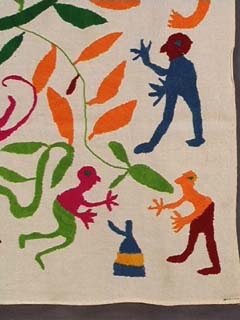|
|
|
Mid-20th Century Huichol Indian Shaman Ritual Embroidered Cloth |
||||
 |
 |
|||
 |
 |
|||
 |
 |
|||
|
|
||||
|
|
||||
|
Mid-20th Century Huichol Indian Shaman Ritual Embroidered Cloth
The Huichol, one of the few Indian groups of Mesoamerica that has managed to preserve their indigenous religion, inhabit the Sierra Madre of Western Mexico. Their Cosmic Center is located in the desert of San Luis Potosi and is called Wirikuta, land of the divine ancestors—place of the sacred peyote—where a person must journey at least five times before he can become a shaman, or a mara'akame. These yarn images, or nearika (meaning 'face', 'aspect', 'design'), are considered expressions of their ceremonial art, depicting the many aspects of the shamans journy into the Other World. (Ripinsky-Naxon). The subject of this embroidered piece is a visionary journey encountering beings in the three worlds connected by the World Tree. These visions, induced by drinking alcohol or ingesting peyote, were part of the shamans healing journey. The figure with the hat, perhaps the shaman, lassoes a fallen spirit in order to subdue it's negative influences over the human beings. The colors are very vibrant and the beings depicted are both whimsical and pesky. The large bird in the center must be the shamans helper. Today, these visionary images are still made but as paintings of yarn embedded in beeswax rather than embroidered. These older embroidered pieces were much more time-consuming to make. This one interestingly has a small embroidered line in the lower right corner reminding me of the spirit lines sometimes woven into Navajo rugs so the maker's spirit will not become trapped in the image. Materials are cotton muslin fabric, colored embroidery thread. Size: 27 1/2" x 32 1/2" Date: 1950-1960's Item #amin029 —SOLD— |
||||
|
|
|
|
E-MAIL US NOW: |
Golden Thread Antiques
Minneapolis, Minnesota Phone: 612.801.7552 to send an e-mail inquiry: GOLDEN THREAD CONTACT FORM |